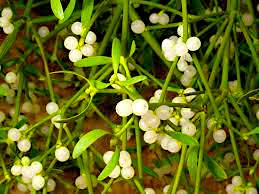
~ Press release issued by Virginia Farm Bureau Federation
BLACKSBURG — Mistletoe lore dates back centuries — to the Celtic druids and Norse mythology — as a symbol of fertility, peace and love.
The plant’s legends eventually made their way across continents when European settlers immigrated to North America and discovered a plant that closely resembled the mistletoe from their homeland.
“(European mistletoe) is actually a different species and different genus, but they look really similar,” explained Jordan Metzgar, a biologist and curator for the Massey Herbarium at Virginia Tech. “When Europeans came to North America, there was this other mistletoe here, so they just transferred a lot of the mythology and traditions with it.”
Metzgar explained that of the seven native mistletoe species in the U.S., only one grows in Virginia—Phoradendron leucarpum—commonly called American mistletoe or Eastern mistletoe. And while it’s the plant of holiday romance, its true characteristics are a little more ominous.
“It’s in the genus Phoradendron, which literally translates to ‘tree thief,’” Metzgar said. “It grows on trees, taps into their vascular systems and steals nutrients and water from them.”
Mistletoe’s tiny white flowers form into clusters of snow-white berries during the late fall and winter, and are a favorite among birds, which spread them from tree to tree. The seed’s sticky coating adheres it to limbs and trunks where “it’ll germinate and make a little seedling, and right away it bores into the tree it’s growing on” using a special rootlike organ called a haustorium, Metzgar explained.
A hemiparasite, the woody shrub needs trees to survive, but it also photosynthesizes, allowing it to stay a festive green throughout the winter. But despite being closely associated with wintertime holidays, “it’s really not cold-tolerant at all,” Metzgar noted. “We’re pretty close to the northern edge of its range here in the Eastern U.S.”
Mistletoe thrives in the temperate climate of Virginia’s coastal plains and swampy forests. Its bushy clumps can easily be spotted standing out against bare branches during the late fall, winter and early spring.
And though the large clusters can damage trees and girdle limbs, mistletoe is a long-established native and a normal part of the forest ecosystem. It grows on a range of trees, particularly oaks, red maples and gum trees.
Some landowners harvest Virginia mistletoe on their own, but others can find sprigs for their holiday decorations at local florists, garden centers, nurseries and other holiday retailers. Many tree farms also sell it alongside their Christmas trees.
Mistletoe may be favored for holiday décor, but it’s best to keep away from children and pets. It contains a toxic protein called phoratoxin, which can cause nausea, vomiting, weakness and other issues when accidentally consumed.
See more in Cultivate magazine at bit.ly/3Gy0KHu.
•••
RELATED ARTICLES
Page County 4-H starting new club, Cloverbuds to hold first meeting Jan. 8
November brings above average rain, but annual rainfall still 13.3 inches below average
Shenandoah Elementary among grant recipients from Virginia Agriculture in the Classroom
Economists predict Thanksgiving turkey prices will be lower this year



Be the first to comment